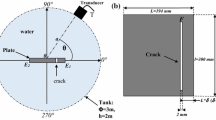Abstract
The problem of electromagnetic wave diffraction by a conducting rod has been solved using the integral equation technique. The diagram of backward scattering has been plotted. A wavelet packet decomposition of the obtained characteristic has been carried out. Based on the values of Shannon entropy for decomposition components we have constructed the feature vector. We have trained a neural network based on radial basis elements, which allows one to determine the position of a rod and its spatial orientation based on the feature vector. Numerical simulation and statistical analysis of the numerical results have been carried out.
Similar content being viewed by others

References
O. P. Soldatova, A. A. Garshin, “Convolutional neural network applied to handwritten digits recognition,” Computer Optics 34(2), 252 (2010), http://www.computeroptics.smr.ru/KO/PDF/KO34-2/13.pdf.
S. Haykin, Neural Networks: A Comprehensive Foundation (Prentice Hall, Upper Saddle River, New Jersey, 2009).
D. L. Colton, R. Kress, Integral Equation Methods in Scattering Theory (John Wiley & Sons, New York, 1983), DOI: 10.1002/zamm.19850650104.
Chi-Man Pun, Moon-Chuen Lee, “Log-polar wavelet energy signatures for rotation and scale invariant texture classification,” IEEE Trans. Pattern Analysis Machine Intelligence 25, No. 5, 590 (May 2003), DOI: 10.1109/TPAMI.2003. 1195993.
Walton C. Gibson, The Method of Moments in Electromagnetics (CRC Press, New York, 2008), 272 p.
John L. Volakis, Kubilay Sertel, Integral Equation Methods for Electromagnetics (SciTech, Ohio, 2012), 408 p.
Matthew N. O. Sadiku, Numerical Techniques in Electromagnetics, 2nd ed. (CRC Press, New York, 2001), 750 p.
R. Mittra (ed.), Computer Techniques for Electromagnetics (Pergamon Press, NY, 1973).
I. Daubechies, Ten Lectures on Wavelets (SIAM, 1992).
C. K. Chui, An Introduction to Wavelets (Academic Press, 1992).
L. D. Goldstein, N. V. Zernov, Electromagnetic Fields and Waves (Sov. Radio, Moscow, 1971) [in Russian].
Author information
Authors and Affiliations
Corresponding author
Additional information
Original Russian Text © D. Lyasota, V.M. Morozov, A. Syanov, 2015, published in Izv. Vyssh. Uchebn. Zaved., Radioelektron., 2015, Vol. 58, No. 8, pp. 42–48.
About this article
Cite this article
Lyasota, D., Morozov, V.M. & Syanov, A. Determination of position and orientation of conducting rod using a neural network. Radioelectron.Commun.Syst. 58, 371–377 (2015). https://doi.org/10.3103/S0735272715080051
Received:
Published:
Issue Date:
DOI: https://doi.org/10.3103/S0735272715080051



